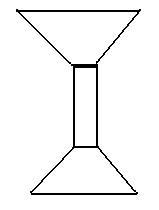 The Write Place: Guides for Writing and Grammar .............................Home
The Write Place: Guides for Writing and Grammar .............................HomeThe Nature of an Essay: Unity and Essay Form
Essays by definition develop one point. The focus on a single idea is what distinguishes essays from other types of writing like memos, reports, articles, or more literary writing like biographies or stories. The term used to refer to this "single-naturedness" of essays is "unity." An essay that keeps its focus on its single "idea" is said to be "unified." If an essay diverges from its main idea (or thesis), it is said to have a problem with unity.
Traditionally, essays have been considered to have an "hour glass" shape. In this view of an essay, the writer begins his or her introduction very broadly and generally and then narrows down to the point of the essay. The body of the essay stays at this narrow level of generality until the conclusion. In the conclusion, the writer reverses the movement of the introduction by restating the main point of the essay and then opening up again into more general comments.
|
 |
General Subject Body focuses on developing the thesis Restate thesis |
Generally, for the typical short college essay of 2-5 pages, writers are well-served to have a single paragraph introduction and conclusion. As essays get longer (10-15 pages), writers might be ok with multi-paragraph introductions.
Introductions:
A good way, then, for you to write your introduction is to move from SUBJECT
to QUESTION to ANSWER. Starting with the general subject, you funnel down
to one issue or question related to that subject, and then narrow even
further to the specific point you wish to make on the topic or question.
(See also Orienting Yourself Toward
an Essay Topic and Leads.)This
sequence to your introduction accomplishes the movement from general to
specific which is so crucial to the logic of the essay. Although there
certainly are different ways to write an introduction, I urge you to write
an introduction that moves from subject to question/issue to answer/position
for these reasons:
- It is clear
- General to specific is a pattern repeated throughout the essay, since it is the movement of making a point and supporting it, so it is important to establish this pattern early.
- The reader will be looking for your thesis (position) to come at the end of your introduction. By placing the thesis at the end of the introduction, you place it in an easily recognizable place.
You don't necessarily need to start with the subject, but it is important that you at least include the essence of the question or issue the essay focuses on. The reader may also need background information to understand the context for your essay question. Also, the best place for your thesis or position is at the end of the introduction (since it is most specific). Some people start their introductions with the thesis first, which can work fine, but I disagree with this approach because it doesn't follow the movement of general to specific.
In short, your main purpose in the introduction is to introduce to the reader what the essay is all about (the question or issue) and what in particular you have to say (the thesis or position). Your goal in the introduction is to make your point, so you don't need to worry about proving or supporting your position at this point. If you find yourself including arguments in the introduction for why you believe your point, you can cut them out and move them into the body of the essay.
The
Body:
The body is where you support your main point or position. The body usually
is divided into a number of paragraphs, and each paragraph contains a
single main support for the position. As the largest part of your essay,
the body may take up 70 to 80% of the essay. If you find that 50% of your
essay is introduction and conclusion, that means you probably don't have
enough support. For more on organizing the Body of the essay, see Organization.
For more on supporting within the Body of the essay, see Development.
Conclusions:
I think there are a number of important things a conclusion should do:
1) it should signal clearly to the reader that this is the conclusion,
2) it should restate the main point of the essay, and 3) it should give
the reader something to think about at the end. You can summarize the
main supports of your essay, but usually this sounds redundant and mechanical.
If the introduction moves from general to specific, then the conclusion
moves in the opposite way from specific to general. Although I don't feel
strongly about following the reverse pattern of position-issue-subject,
I do urge you to begin the conclusion with some sort of restatement of
your main point. For example: "In conclusion, government regulation
of TV violence would be bad for all of us."
A writing teacher I had once
urged us to ask this question when we sat down to write our conclusion:
"What does it all add up to?" Whatever way you structure your
conclusion, be sure that it includes a restatement of you main idea or
position.

Free Web Counter
(Since 1/12/16)

This work is licensed under a Creative Commons Attribution-NonCommercial 4.0 International License | Contact Lirvin | Lirvin Home Page | Write Place Home